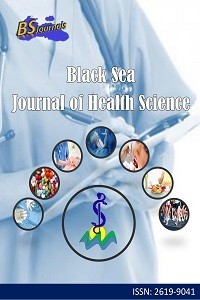Kutanöz Leishmaniasis Şüpheli Olgulardan Leishmania Parazitinin Araştırılması
Kutanöz Leishmaniasis, Leishmania, Amastigot, Giemsa boyama, Polimeraz zincir reaksiyonu
Investigation of Leishmania Parasite from Suspected Cases of Cutaneous Leishmaniasis
Cutaneous Leishmaniasis, Leishmania, Amastigote, Giemsa staining, Polymerase chain reaction,
___
- Akkafa F, Dilmec F, Alpua Z. 2008. Identification of Leishmania parasites in clinical samples obtained from cutaneous leishmaniasis patients using PCR-RFLP technique in endemic region, Sanliurfa province, in Turkey. Parasitol Res, 103: 583-586.
- Alawieh A, Musharrafieh U, Jaber A, Berry A, Ghosn N, Bizri AR. 2014. Revisiting leishmaniasis in the time of war: the Syrian conflict and the Lebanese outbreak. Int J Infect Dis, 29: 115-119.
- Chargui N, Bastien P, Kallel K, Haouas N, Akrout FM, Masmoudi A. 2005. Usefulness of PCR in the diagnosis of cutaneous leishmaniasis in Tunisia. Trans R Soc Trop Med Hyg, 99(10): 762-768.
- Cömert-Aksu M, Deniz S, Togay A, Güneş F. 2020. Mersin ilinde 2010-2015 yılları arasında tanı konulan kutanöz leishmaniasis olgularının epidemiyolojik olarak değerlendirilmesi. Turk Hij Den Biyol Derg, 2020: 139-148
- Çizmeci Z, Karakuş M, Karabela Ş N, Erdoğan B, Güleç N. 2019. Leishmaniasis in Istanbul; A new epidemiological data about refugee leishmaniasis. Acta Trop, 195: 23-27.
- Dietmar S. 2017. The history of leishmaniasis. Parasit Vectors, 10: 1-10.
- Galluzzi L, Ceccarelli M, Diotallevi A, Menotta M, Magnani M. 2018. Real-time PCR applications for diagnosis of leishmaniasis. Parasit Vectors, 11: 1-13.
- Harman M. 2015. Leishmaniasis. Turk J Dermatol, 9(4): 168-176.
- Hayani K, Dandashli A, Weisshaar E. 2015. Cutaneous leishmaniasis in Syria: clinical features, current status and the effects of war. Acta Derm Venereol, 95(1): 62-66.
- Inci R, Ozturk P, Mulayim M K, Ozyurt K, Alatas ET, Inci MF. 2015. Effect of the Syrian civil war on prevalence of cutaneous leishmaniasis in southeastern Anatolia, Turkey. Med Sci Monit, 21: 2100.
- Kima PE. 2007. The amastigote forms of Leishmania are experts at exploiting host cell processes to establish infection and persist. Int J Parasitol, 37(10): 1087-1096.
- Koltaş IS, Eroglu F, Uzun S, Alabaz D. 2016. A comparative analysis of different molecular targets using PCR for diagnosis of old world leishmaniasis. Exp Parasitol, 164: 43-48.
- Korkmaz S, Özgöztaşı O, Kayıran N. 2015. Gaziantep Üniversitesi Tıp Fakültesi Leishmaniasis Tanı ve Tedavi Merkezine başvuran kutanöz leishmaniasis olgularının değerlendirilmesi. Turkiye Parazitol Derg, 39: 13-16.
- Muhjazi G, Gabrielli AF, Ruiz-Postigo JA, Atta H, Osman M, Bashour H. 2019. Cutaneous leishmaniasis in Syria: A review of available data during the war years: 2011–2018. PLOS Negl Trop Dis, 13(12): e0007827.
- Özbilgin A, Töz S, Harman M, Topal S G, Uzun S, Okudan F. 2019. The current clinical and geographical situation of cutaneous leishmaniasis based on species identification in Turkey. Acta Trop, 190: 59-67.
- Özkeklikçi A, Karakuş M, Özbel Y, Töz S. 2017. The new situation of cutaneous leishmaniasis after Syrian civil war in Gaziantep city, Southeastern region of Turkey. Acta Trop, 166: 35-38.
- Salman İ S, Vural A, Ünver A, Saçar S. 2014. Nizip’te, S.İ.S.S., olguları. Mikrobiyol Bul, 48 (1): 106-113.
- Sunter J, Gull K. 2017. Shape, form, function and Leishmania pathogenicity: from textbook descriptions to biological understanding. Open Biol, 7(9): 170165.
- WHO. 2023. Leishmaniazis Fact sheet 2023. URL: https://www.who.int/news-room/fact-sheets/detail/leishmaniasis (erişim tarihi:28 Eylül 2023).
- Yayın Aralığı: Yılda 4 Sayı
- Başlangıç: 2018
- Yayıncı: Cem TIRINK
Tfh and Tfr Cells in Autoimmune Diseases
Gulam HEKİMOĞLU, Nurullah YÜCEL, Muzaffer ŞEKER
Kutanöz Leishmaniasis Şüpheli Olgulardan Leishmania Parazitinin Araştırılması
Aya İSAOĞLU, Hamide KAYA, Leyla ERSOY, Seda TEZCAN ÜLGER, Gönül ASLAN
İnme Sonrası Cinsel İşlev Bozukluğunda Hemşirenin Sorumlulukları
Burcu SÜTCÜ, Gülşah ÇAMCI, Hatice KARABUĞA YAKAR, Sıdıka OĞUZ
Fahrettin KAYA, Ercan EFE, Fatih ÜÇKARDEŞ
Nursing Students' Occupational Motivation, Occupational Commitment Levels and Related Factors
Student Views on Distance Education of Anatomy Course in the Covid-19 Process
Hastaların Hastaneye Yatış Anındaki Malnütrisyon Durumunun ve Yaşam Kalitesinin Belirlenmesi
Fatma NİŞANCI KILINÇ, Çiler ÖZENİR, Sevinç EŞER DURMAZ, Aylin BAYINDIR GÜMÜŞ, Biriz ÇAKIR
Hanife ABAKAY, Ayşe ATİLABEY GÜÇ, Hanife DOĞAN, Özlem BALBALOĞLU
